This article has multiple issues. Please help improve it or discuss these issues on the talk page. (Learn how and when to remove these messages)
|
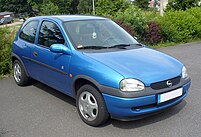 Opel Corsa B
Opel Corsa B Chevrolet Corsa
Chevrolet Corsa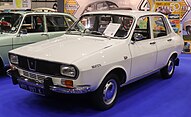 Renault 12
Renault 12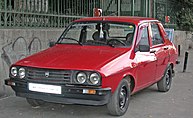 Dacia 1310Two examples of rebadging in Opel (above) and Renault vehicles. The Corsa has also been rebadged under other marques of General Motors such as Vauxhall or Holden.
Dacia 1310Two examples of rebadging in Opel (above) and Renault vehicles. The Corsa has also been rebadged under other marques of General Motors such as Vauxhall or Holden.
In the automotive industry, rebadging is a form of market segmentation used by automobile manufacturers around the world. To allow for product differentiation without designing or engineering a new model or brand (at high cost or risk), a manufacturer creates a distinct automobile by applying a new "badge" or trademark (brand, logo, or manufacturer's name/make/marque) to an existing product line.
Rebadging is also known as rebranding and badge engineering; the latter is an intentionally ironic misnomer in that little or no actual engineering takes place. The term originated with the practice of replacing an automobile's emblems to create an ostensibly new model sold by a different maker. Changes may be confined to swapping badges and emblems, or may encompass minor styling differences, as with cosmetic changes to headlights, taillights, front and rear fascias, and even outer body skins. More extreme examples involve differing engines and drivetrains. The objective is "to spread the huge development costs of a new vehicle over as many cars as possible". An example is General Motors' rebadging of the Camaro as the Firebird, a successful model from the 1960s through to the 2000s. In most cases, consumers are interested in each brand's focus "on the unique elements of styling and driving characteristics". Some cars would not be marketed without the cost savings that are obtained from this practice, and carmakers can develop many "different models – all wearing different badges – off the one platform".
In several countries including Japan, manufacturers often use the phrase "OEM supply" or "OEM-supplied" to denote vehicles that are a rebadged model from or for other manufacturers.
Although platform sharing can often involve rebadging and rebranding, it can extend further, as the design may be used across multiple configurations. For example, a single platform may underpin a sedan, hatchback, or SUV/CUV body designs.
Automotive industry rebadging can be compared with white-label products in other consumer goods industries, such as consumer electronics and power tools.
History
The first case of badge engineering appeared in 1917 with the Texan automobile assembled in Fort Worth, Texas, that made use of Elcar bodies made in Elkhart, Indiana.
"Probably the industry's first example of one car becoming another" occurred in 1926 when Nash Motors' newly introduced smaller-sized Ajax models were discontinued in 1926 after over 22,000 Ajax cars were sold during the brand's inaugural year. The chairman and CEO of the company, Charles W. Nash, ordered that the Ajax models be marketed as the "Nash Light Six", Nash being a known and respected automobile brand. Production was stopped for two days so Nash emblems, hubcaps, and radiator shells could be exchanged on all unshipped Ajax cars. Conversion kits were also distributed at no charge to Ajax owners to transform their cars and protect the investment they had made in purchasing an automobile made by Nash.
Starting with the beginning of General Motors in 1909, chassis and platforms were shared with all brands. GMC, which historically was a truck builder, began to offer its products branded as Chevrolet, and vehicles produced by GM were built on common platforms shared with Chevrolet, Oakland, Oldsmobile, Buick, and Cadillac. Exterior appearances were gradually upgraded between these vehicle brands. This was partly because all bodywork was provided by Fisher Body which was bought by GM in 1925, and the introduction of the Art and Color Section in 1928, directed by Harley Earl. For the 1958 model year, GM was promoting its fiftieth year of production and introduced anniversary models for each brand; Cadillac, Buick, Oldsmobile, Pontiac, and Chevrolet. The 1958 models shared an almost identical appearance on all models for each brand and made special luxury models with a shared appearance; Cadillac Eldorado Seville, Buick Limited Riviera, Oldsmobile Starfire 98, Pontiac Bonneville Catalina, and the Chevrolet Bel-Air Impala.
 1958 Chevrolet Bel Air Impala Convertible
1958 Chevrolet Bel Air Impala Convertible 1958 Pontiac Bonneville Catalina
1958 Pontiac Bonneville Catalina
 1958 Oldsmobile 98 Convertible
1958 Oldsmobile 98 Convertible 1958 Buick Limited Riviera
1958 Buick Limited Riviera 1958 Cadillac Eldorado Seville
1958 Cadillac Eldorado Seville
A later example was Wolseley Motors after it was bought out by William Morris. After World War I, "Wolseley started to lose its identity and eventually succumbed to badge engineering." This was repeated with the consolidation of Austin Motor Company and the Nuffield Organization (parent company of Morris Motors) to form the British Motor Corporation (BMC). The rationalization of production to gain efficiencies "did not extend to marketing", and each "model was adapted, by variation in trim and accessories, to appeal to customer loyalties for whom the badge denoting the company of origin was an important selling advantage ... 'Badge Engineering', as it became known, was symptomatic of a policy of sales competition between the constituent organizations". The ultimate example of BMC badge engineering was the 1962 BMC ADO16 which was available badged as a Morris, MG, Austin, Wolseley, Riley and the upmarket Vanden Plas. A year earlier, the Mini was also available as Austin, Morris, Riley, and Wolseley – the latter two having slightly bigger boots.
Examples
Regional brands
Badge engineering often occurs when an individual manufacturer (such as the regional Big Threes of the United States, Europe, and Japan) owns a portfolio of different brands and markets the same car under different brands and nameplates. The practice is used for multiple reasons. In one example, a company may do so to expand its range of different brands in a market without the cost of developing completely new models. In the United States, General Motors may sell a car through each brand; for example, the Chevrolet Tahoe, GMC Yukon, and Cadillac Escalade each share a common body.
In another example, the same model is rebadged when it is sold in different regions and markets. In Australia, during the 1980s and 1990s, the Button car plan required imported Nissans and Toyotas to adopt Ford and Holden (GM) nameplates. In the United Kingdom, Opel-produced vehicles are marketed under the Vauxhall brand; when sold in the United States, Opels were marketed as Saturns, Chevrolets, and Buicks. Conversely, the Australian Holden brand was never sold in North America, but the Holden Monaro and Holden Commodore were sold under the Pontiac (Pontiac GTO, Pontiac G8), Chevrolet (Chevrolet SS), and Buick (Buick Regal Sportback/Buick Regal TourX) nameplates.
 Holden Monaro
Holden Monaro Pontiac GTO
Pontiac GTO Vauxhall Monaro
Vauxhall Monaro
Brand expansion
Another way badge engineering may occur is when two separate manufacturers trade products, filling gaps in their respective product lineups. During the 1990s, Honda and Isuzu entered into such an agreement, with Isuzu marketing the first-generation Honda Odyssey as the Isuzu Oasis as its first minivan. In return, Honda received the Isuzu Rodeo and Isuzu Trooper SUVs, which became the Honda Passport and Acura SLX; the agreement allowed both Honda and Isuzu to enter new vehicle segments without the cost of engineering an all-new vehicle design (at the same time, in Europe, the Honda Crossroad was a rebadged Land Rover Discovery).
During the late 2000s and early 2010s, the Volkswagen Routan was a rebranded version of the Dodge Grand Caravan, supplied as Volkswagen sought to re-enter the North American minivan segment without the investment of federalizing its design. Assembled by Chrysler with a Chrysler powertrain, the Routan received its own styling and content features as well as a standard "sportier suspension and steering".
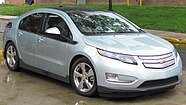
 The Chevrolet Volt (left) and the Opel Ampera (right) are two mechanically, internally, and near-externally identical cars that share the majority of their components, however feature various different stylistic elements to cater to the design language of each brand.
The Chevrolet Volt (left) and the Opel Ampera (right) are two mechanically, internally, and near-externally identical cars that share the majority of their components, however feature various different stylistic elements to cater to the design language of each brand.
Distribution networks (Japan)
In Japan, automobile manufacturers differed in the marketing of their product ranges. In contrast to marketing a single vehicle under multiple brand names (with minor changes to exterior bodywork), Japanese manufacturers marketed vehicles through multiple sales networks, with a distinct vehicle being sold under various model nameplates (from a single manufacturer).
Toyota marketed the Corolla in Japan exclusively at Toyota Corolla Store locations; at Toyota Auto Store locations, it was named the Toyota Sprinter. Nissan sold the Nissan Cedric through its Nissan Bluebird Store network, with the identical Nissan Gloria through the Nissan Prince Store network. Honda previously marketed the Honda Accord through multiple sales networks, marketing the Accord through the Honda Clio network and renaming it as the Honda Vigor for Honda Verno locations (conversely, the Vigor was renamed the Honda Inspire for the Clio network).
The practice of producing multiple versions of the same vehicle would eventually lead to distinct vehicles produced for export. In North America, the Toyota Sprinter was marketed as the Chevrolet Nova (and the Geo Prizm that replaced it). The Honda Vigor and Inspire were marketed as the Acura Vigor and TL; Nissan sold the Gloria in the United States as the Infiniti M45.
 Toyota Corolla
Toyota Corolla Toyota Sprinter
Toyota Sprinter Honda Accord
Honda Accord
 Honda Vigor
Honda Vigor Nissan Cedric
Nissan Cedric Nissan Gloria
Nissan Gloria
Joint ventures
Two automakers can also pool resources by operating a joint venture to create a product and then selling each as their own. For example, General Motors and Toyota formed NUMMI. The vehicles produced from this venture (though not necessarily at NUMMI itself) included the Toyota Sprinter/Chevrolet Prizm, and later the Toyota Matrix/Pontiac Vibe. In another agreement, Ford and Nissan developed and produced the Mercury Villager and Nissan Quest minivans from 1993 through 2002.
Another example was the cooperative work between Volkswagen and Ford to develop the VW Sharan, Ford Galaxy, and SEAT Alhambra.
 Pontiac Vibe
Pontiac Vibe Toyota Matrix
Toyota Matrix Toyota Voltz
Toyota Voltz
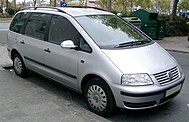 VW Sharan
VW Sharan Ford Galaxy
Ford Galaxy SEAT Alhambra
SEAT Alhambra
Badge engineering may occur when one company allows another, otherwise unaffiliated, company to market a revised version of their product through an OEM deal, as with Volkswagen marketing a modified version of the Dodge Caravan and Chrysler Town and Country minivans as the Volkswagen Routan (2009–2014).
Another example was the joint venture of Mitsubishi and Chrysler that resulted in vehicles produced by Diamond-Star Motors that were marketed under various nameplates from 1985 until 1993.
 Chrysler Town & Country
Chrysler Town & Country(fifth generation)
 Dodge Grand Caravan
Dodge Grand Caravan(fifth generation)
 Volkswagen Routan
Volkswagen Routan Lancia Voyager
Lancia Voyager
China
In China, foreign manufacturers were required to form a joint venture with a local manufacturer to manufacture automobiles in the country. Prior to 2022, the Chinese government dictates that no more than two joint ventures are allowed for each foreign investor. Larger foreign manufacturers often set up two joint ventures to maximize the market reach, including Toyota (FAW Toyota and GAC Toyota), Ford (JMC-Ford and Changan Ford), Volkswagen (SAIC-VW and FAW-VW) and Honda (Dongfeng Honda and Guangqi Honda). To distribute the production and sales rights to each joint venture, manufacturers often resort to a similar strategy deployed in Japan: simply producing the exact model under two different names with minor changes to exterior bodywork.
GAC Toyota has produced the Levin as a twin model to the FAW Toyota-built Corolla and the Wildlander as the alternative to the RAV4. Honda awarded several models to two joint ventures, which spawned the Breeze from the original CR-V, the Elysion from the Odyssey, the XR-V from the HR-V, and others.
 FAW-Toyota Corolla
FAW-Toyota Corolla GAC-Toyota Levin
GAC-Toyota Levin
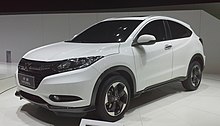 GAC-Honda Vezel
GAC-Honda Vezel Dongfeng-Honda XR-V
Dongfeng-Honda XR-V
In other cases, foreign manufacturers may also rebadge a model developed by its partner, sometimes for exports to other markets. Examples include the second generation Chevrolet Captiva which is an export version of the Baojun 530 made by SAIC-GM-Wuling, or the Ford Territory, a reworked version of the Yusheng S330 developed by Jiangling Motors (JMC).
 JMC Yusheng S330
JMC Yusheng S330 Ford Territory
Ford Territory
Life cycle extension
Badge engineering could be used as a strategy to lengthen the life cycle of a vehicle. After a product has reached the end of its life cycle, it may be transferred to another brand, mostly from the same holding company or joint venture. Examples include the SEAT Exeo, a rebadged Audi A4 B7 with reworked styling, which was built in Spain from used production tooling from the Audi plant in Ingolstadt after the A4 B7 production had ended. The tooling was dismantled from Ingolstadt and was sent to the SEAT manufacturing plant in Martorell, Spain, to be reinstalled.
Another example is the Dongfeng Fengdu MX6, which was produced after the near-identical Nissan X-Trail (T31) production had ended, and the Maruti Suzuki Zen Estilo, which is based on the then-recently discontinued Suzuki MR Wagon. The advantage of this strategy is amortized tooling costs, which means the vehicle can be produced at a higher margin of profit (or a lower price, or both).
 Audi A4 (B7)
Audi A4 (B7) SEAT Exeo
SEAT Exeo
 Nissan X-Trail (T31)
Nissan X-Trail (T31)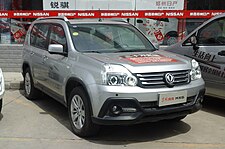 Dongfeng Fengdu MX6
Dongfeng Fengdu MX6
Luxury vehicles
Badge engineering occurs in the luxury-type market segments. An automobile manufacturer will use a model from its mainstream brand as a basis for a model under a premium marque by upgrading its features, technology, and/or styling. Along with visible cosmetic differences, premium models may also receive upgraded drivetrains.
An example of this is that Ford Motor Company marketed its mainstream Ford Fusion mid-size sedan as the Lincoln MKZ; the Ford Expedition SUV is sold as the Lincoln Navigator. A more controversial example was the Aston Martin Cygnet, a rebadged version of the Toyota iQ city car (intended to comply with EU emissions regulations). While fitted with model-specific trim and a luggage set, the Cygnet nearly tripled the price of the iQ. Alternatively, VW Group under Ferdinand Piëch used the reverse of this in some circumstances, engineering the more luxurious model first and then remove features for models from less prestigious marques. Examples include the Lamborghini Gallardo/Audi R8 and the Audi A4/Volkswagen Passat.
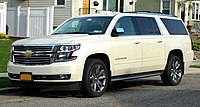 Chevrolet Suburban
Chevrolet Suburban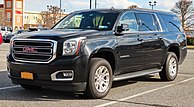 GMC Yukon XL
GMC Yukon XL Cadillac Escalade ESV
Cadillac Escalade ESV
 Ford Expedition
Ford Expedition Lincoln Navigator L Black Label
Lincoln Navigator L Black Label
 Ford Fusion
Ford Fusion Mercury Milan
Mercury Milan Lincoln MKZ (Zephyr)
Lincoln MKZ (Zephyr)
Platform sharing
Along with rebadging and badge engineering, platform sharing is common throughout the automotive industry. Alongside a shared chassis (though unibody construction is nearly universal in cars and many light trucks), platform sharing also standardizes components such as drivetrain, suspensions, components, and other technologies. General Motors used the B platform for many of its non-Cadillac full-size vehicles (nearly exclusively from 1959 through 1985), while Chrysler used its B platform for intermediates and its C platform for (non-Imperial) full-size cars.
The Volkswagen Group uses platform sharing as its business strategy to improve its profitability and growth. For example, Audi uses components from their more pedestrian counterparts, sold as Volkswagen mass-market brands. As an effort to place Audi as a "premium" marque, Volkswagen often introduces new technologies in Audi-branded cars before fitting them to mainstream products (such as the Direct-Shift Gearbox). In production, platform sharing is used extensively, with the modular MQB platform underpinning a range of vehicles from the Audi A1 to the Volkswagen Atlas. The previous D platform of the 2000s was used for the Volkswagen Phaeton and Bentley Continental GT (built in steel) and the Audi A8 (built in aluminum).
In the Japanese automotive industry, platform sharing has expanded model offerings in North America. While the initial Lexus LS was developed specifically for the American market, the later Lexus ES has shared a platform (but not a body) with the Toyota Camry (since 2013, the Toyota Avalon, itself also based on the Camry). Exclusive primarily to North America, Honda uses a common platform to produce the American version of the Odyssey minivan, also underpinning the Honda Pilot and Honda Passport SUVs, the Acura MDX CUV, and the Honda Ridgeline mid-size pickup truck.
 Holden Commodore (VE)
Holden Commodore (VE) Chevrolet Camaro (fifth generation)The Fifth generation Chevrolet Camaro was based on the Holden developed General Motors Zeta platform, originally used by the VE series Holden Commodore.
Chevrolet Camaro (fifth generation)The Fifth generation Chevrolet Camaro was based on the Holden developed General Motors Zeta platform, originally used by the VE series Holden Commodore.
Problems and controversy
Although intended to save development costs by spreading design and research costs over several vehicles, rebadging can also become problematic if not implemented properly. Using multiple car brands under a single-parent manufacturer can significantly increase selling costs, as each model line must be marketed separately, requiring a distinct dealership network. Inappropriate use of rebadging can also hurt overall sales by resulting in "cannibalism" between two or more brands owned by the same company by failing to develop a distinct image for each brand or by allowing the market failure of one version of a model to carry over to its rebadged model counterparts.
Through the 2000s, the American Big Three automakers reduced their brand footprint by closing or selling underperforming brands. After 2001, Chrysler discontinued its Plymouth brand (following the closure of Eagle in 1998). In response to the late 2000s recession, Ford ended its ownership of Jaguar, Land Rover, Aston Martin, and Volvo Cars; in 2010, Mercury was closed by Ford. General Motors underwent several brand revisions; following the discontinuation of the Geo sub-brand of Chevrolet in 1997, Oldsmobile was closed after 2004 (the oldest American nameplate at the time). Following its 2009 bankruptcy, GM closed Pontiac, Saturn, and Hummer in 2010; Saab was sold (eventually leading to its demise). GM sold its European Opel and Vauxhall brands in 2017 to PSA (now Stellantis).
GM X/H platform compacts
In response to the 1973 oil crisis, General Motors expanded fuel-efficient offerings beyond its Chevrolet division, reintroducing compact cars to its Buick, Oldsmobile, and Pontiac brands. Derived from the X-platform Chevrolet Nova, the Pontiac Ventura was introduced for the 1971 model year, with the Buick Apollo and Oldsmobile Omega introduced for 1973. These four X-platform vehicles (also known as N-O-V-A from the first letters of their model names) were produced with identical bodies with divisional differences marked only with specific grille, lamp, and body trim variations.
To expand its footprint in the subcompact segment, the H-body Chevrolet Vega platform was used for the 1975 model year for newly styled variants sold as the Chevrolet Monza, Buick Skyhawk, and Oldsmobile Starfire followed by the 1976 Pontiac Sunbird. Similarly, to the X-body vehicles, the H-body subcompacts shared common bodies across all four divisions with differing grille, lamp, and body trim variations.
- 1971–1979 GM X-body (compact)
-
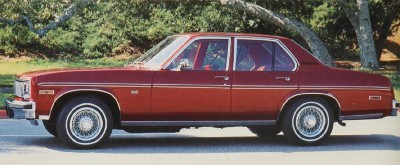 1978 Chevrolet Nova
1978 Chevrolet Nova
-
 1973 Buick Apollo
1973 Buick Apollo
-
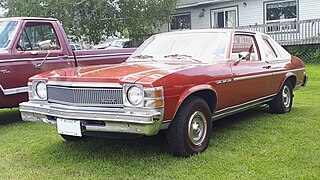 1979 Buick Skylark
1979 Buick Skylark
-
 1978 Oldsmobile Omega
1978 Oldsmobile Omega
-
 1973 Pontiac Ventura
1973 Pontiac Ventura
-
 1977 Pontiac Phoenix
1977 Pontiac Phoenix
- 1975–1980 GM H-body (subcompact)
-
 1978 Chevrolet Monza (hatchback)
1978 Chevrolet Monza (hatchback)
-
 1977 Chevrolet Monza (coupe)
1977 Chevrolet Monza (coupe)
-
 1975 Buick Skyhawk
1975 Buick Skyhawk
-
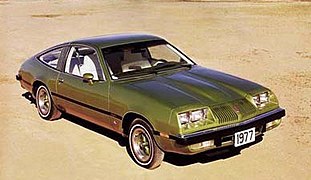 1977 Oldsmobile Starfire
1977 Oldsmobile Starfire
-
 1978 Pontiac Sunbird (coupe)
1978 Pontiac Sunbird (coupe)
GM divisional engines
Prior to 1981, the majority of General Motors vehicles were produced with engines designed by their respective divisions. From 1981 onward, GM ended its policy of divisionally-developed engines, instead offering engines under a singular GM brand. As an exception, Cadillac offers division-exclusive engines (the Northstar and Blackwing V8 engine families).
In 1981, GM lost a 1977 lawsuit related to consumers (who purchased 1977 Oldsmobile Delta 88s equipped with a 350 cu in (5.7 L) Chevrolet small-block engine instead of the 350 cu in (5.7 L) Oldsmobile V8 engine). At the time of production, GM had downsized its full-size model lines in preparation for another oil crisis and had increased production of V6 engines as the intended standard engine, underestimating consumer demand for Oldsmobile V8 engines. To accommodate the increased market demand, nearly 60% of Delta 88s were equipped with a Chevrolet 5.7 L V8 for 1977. The lawsuit was filed by the state of Illinois, claiming GM falsely advertised the vehicles. In 1981, GM settled the lawsuit with the vehicle buyers and discontinued their company-unique policy of division-specific engines. Into the 1990s, GM advertising featured a disclaimer stating '"Oldsmobiles (or any other GM division) are equipped with engines manufactured by various GM divisions, subsidiaries and affiliates worldwide."'
Lincoln Versailles and Cadillac Cimarron

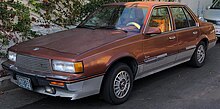
Prior to the mid-1970s, the American luxury brands Lincoln and Cadillac offered model lines consisting entirely of full-size two-door and four-door sedans and full-size personal luxury cars. At the beginning of the decade, European automakers began to market their largest sedans as luxury vehicles in North America. Though the BMW Bavaria/3.0Si, Jaguar XJ6/XJ12, and Mercedes-Benz S-Class (W116) were priced similar to the Cadillac Sedan de Ville and Lincoln Continental, the model lines were thousands of pounds lighter and multiple feet shorter in length (with only the hand-built Rolls-Royce Phantom V rivaling Lincoln and Cadillac in size). In response to both the 1973 oil crisis and to regain lost market share, both Cadillac and Lincoln introduced smaller vehicles for their brand. In one of the most controversial uses of rebranding in automotive history, both vehicles were derived from smaller GM and Ford divisional model ranges.
For the 1977 model year, Lincoln released the Lincoln Versailles to match the debut of the Cadillac Seville. In contrast with the Seville (sharing its chassis underpinnings both the Chevrolet Nova and the Chevrolet Camaro), the Versailles shared nearly its entire body with the Mercury Monarch (itself a counterpart of the Ford Granada); the model line also replaced the previous Mercury Grand Monarch Ghia. Outsold by the Seville nearly three-to-one, the Versailles sold far under sales predictions and was discontinued early in the 1980 model year.
For 1982, Cadillac released the Cadillac Cimarron to compete against compact European-brand executive sedans. The smallest Cadillac produced since the 1900s, the Cimarron used the chassis of the GM J-body four-door sedan. Developed and brought to market less than a year before the J-body was released, Cadillac was left with almost no time to distinguish the Cimarron from its divisional counterparts from Chevrolet, Buick, Oldsmobile, and Pontiac. Though sharing nearly its entire exterior with the four-door Chevrolet Cavalier, the Cimarron was priced nearly twice as high as its counterpart. Additionally, J-body vehicles from other divisions could be equipped nearly identically to the Cimarron for a lower cost. Though the model line closely matched its Buick Skyhawk and Oldsmobile Firenza counterparts in sales, the Cimarron was discontinued following the 1988 model year.
Though the Lincoln Versailles was largely forgotten after its 1980 discontinuation (its role superseded by the downsizing of the Lincoln Continental for 1982), the Cimarron would cause extensive damage to the Cadillac brand, as its market share declined by almost 50% from 1980 to 1998. As of current production, neither Lincoln nor Cadillac has marketed a compact-segment car. Through the use of rebranding, Lincoln produced the mid-size Lincoln MKZ (sharing its doors with the Ford Fusion; as part of its 2013 redesign, no other exterior panels); Cadillac rebranded the Opel Omega B as the Cadillac Catera as its first mid-size car, but replaced it, eventually moving towards platform sharing with other divisions.
GM A-platform
From 1982 until 1986, the front-wheel drive A platform underpinned the Chevrolet Celebrity, Cutlass Ciera, Pontiac 6000, and Buick Century. As part of their legacy, the A-bodies became enormously popular – as well as synonymous with one of GM's most transparent examples of badge engineering: they were simultaneously presented, almost indistinguishably, on the 22 August 1983 cover of Forbes magazine as examples of genericized uniformity, embarrassing the company and ultimately prompting GM to recommit to design leadership.
Eagle (Chrysler)


In 1987, Chrysler Corporation acquired American Motors Corporation (AMC) from Renault, leading to the exit of the latter company from the North American market. As part of the sale, Chrysler obtained the AMC dealership network, the AMC Eagle line of all-wheel drive cars, and the Jeep line of sport-utility vehicles and pickup trucks. For 1989, Chrysler established the Jeep-Eagle Division in a strategy to both focus on Jeep and offer specialty cars differentiated from the established Chrysler lines.
Following the retirement of the AMC Eagle Wagon in early 1988 (derived from the 1971 AMC Hornet), Eagle established its product line with the introduction of the 1988 Premier and Medallion (developed by Renault prior to the sale of AMC). To expand the product range beyond the two sedans, Chrysler sourced vehicles from Mitsubishi, introducing the 1989 Summit (Dodge/Plymouth Colt) and 1990 Talon (Mitsubishi Eclipse). In contrast to the Jeep range, Eagle was marketed towards consumers interested in imported vehicles.
For 1992, the Eagle Vision full-size sedan replaced the Premier, becoming the first Eagle-brand vehicle developed by Chrysler. Positioned between the Dodge Intrepid and Chrysler Concorde, the Eagle Vision shared most exterior trim with the Concorde. It was the only Chrysler LH car offered exclusively with a five-passenger interior.
Coinciding with the 1998 Daimler-Chrysler merger, the Eagle brand was discontinued; the singular Jeep brand was integrated as part of Chrysler or Dodge dealership networks. The Chrysler 300M was originally developed as a second generation of the Eagle Vision; following the discontinuation of Eagle, the vehicle continued into production as a Chrysler model, adopting a slightly restyled grille, Chrysler badging, and a Chrysler interior.
Lexus ES250 and Infiniti M30

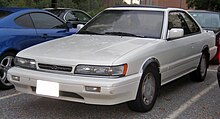
For the 1989 model year, Toyota and Nissan introduced the Lexus and Infiniti luxury brands in the United States (following the Acura luxury brand of Honda) with the all-new Lexus LS400 and Infiniti Q45 full-size sedans. Both brands expanded their model line for 1990, sourcing an existing model line from the Japanese market to rebrand as an entry-level offering.
The Lexus ES250 is a four-door sedan derived from the V20 Toyota Camry. Though visibly similar to the Camry introduced for 1987, the ES250 was a rebranded Toyota Camry Prominent/Vista; a model developed for Japan, the Prominent/Vista (dependent on sales network) is a four-door pillared hardtop sedan with a slightly lower roofline and restyled body panels. Along with the change to left-hand drive, the ES250 adopted an interior similar to the larger LS (along with similarly styled wheels and taillamps).
The Infiniti M30 is a two-door notchback coupe derived from the Nissan Leopard (a model never sold in North America). Along with the coupe, Infiniti sold the M30 as a two-door convertible (converted in the United States). With the exception of its badging and its dashboard (sourced from the left-hand drive Nissan Skyline), the M30 differed from the Leopard primarily in its steering wheel location.
Intended largely as placeholder models, the ES250 and M30 were largely overshadowed by their companion flagship sedans. Following the end of the 1992 model year, both models were withdrawn (as their Japanese counterparts had ended their model cycles). For 1993, the ES250 was replaced by the ES300; while again sharing its body with a Japanese-market Toyota (Toyota Vista/Windom) and its chassis and engine with the Camry, the ES300 shared no resemblance to the American-market Camry. Infiniti moved away from a two-door coupe entirely, replacing the M30 with the four-door J30 (Nissan Leopard J Ferie in Japan).
Rover CityRover

The Rover CityRover, launched in 2003 as the last vehicle from the MG Rover Group, was a rebadged Tata Indica made in India. English motoring journalist George Fowler criticized the MG Rover Group, which was enjoying national sympathy from the British public as the last domestically owned automobile manufacturer, stating the CityRover was "a duplicitous attempt to 'save Rover' by flogging an Indian car on which the only Rover bits were the badges".
Models produced under license
A variant of rebadging is licensing models to be produced by other companies, typically in another country. The earliest such vehicle was the Austin 7 (1922–1939), designed and built by Austin Motor Company and licensed to other manufacturers across continents, which became their first-ever model. The Bantam in the US that would eventually build the first Jeep, BMW in Germany, and Nissan in Japan.
 Austin 7
Austin 7 BMW Dixi
BMW Dixi Nissan Datsun Model 16
Nissan Datsun Model 16 Bantam Speedster
Bantam Speedster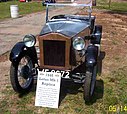 Lotus Mark 1
Lotus Mark 1
Among the post-war cars, the Fiat 124 designed and built by Fiat, Italy was licensed to various other manufacturers from different countries. It became a dominant car in many Eastern Europe and West Asian countries.
 Fiat 124, Italy and various countries
Fiat 124, Italy and various countries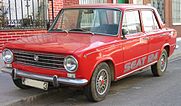 SEAT 124, Spain
SEAT 124, Spain Premier 118NE, India
Premier 118NE, India VAZ-2101 / Lada, Russia and Eastern Europe
VAZ-2101 / Lada, Russia and Eastern Europe Tofaş Murat 124, Turkey
Tofaş Murat 124, Turkey
The Morris Oxford Series IV built by Morris of England in 1955 would become Hindustan Ambassador in India and was manufactured until 2014. Another example of this is the British Hillman Hunter, which was license-built in Iran as the Paykan, as well as Naza, building vehicles under license from Kia and Peugeot (Naza 206 Bestari).
A similar example of licensed badge-engineered products would be the Volga Siber, a rebadged version of the Chrysler Sebring sedan and the Dodge Stratus sedan produced in Russia from 2008 until 2010.
See also
References
- Chambers, Cliff (4 November 2011). "What is badge engineering?". motoring.com.au. Retrieved 6 April 2015.
- ^ Fingleton, Eamonn (7 April 2013). "Same Car, Different Brand, Hugely Higher Price: Why Pay An Extra $30,000 For Fake Prestige?". Forbes. Retrieved 6 April 2015.
- Orlove, Raphael (3 May 2014). "The Ten Best Examples of Badge Engineering". Retrieved 6 April 2015.
- Martin, Murilee. "Badge Engineering". The Truth About Cars. Retrieved 6 April 2015.
- ^ Duff, Craig (28 October 2016). "Badge engineering and shared platforms explained". CarsGuide. Retrieved 6 December 2020.
- Orlove, Raphael (5 March 2014). "The Ten Best Examples of Badge Engineering". Jalopnik. Retrieved 6 December 2020.
- Hagon, Toby (23 July 2020). "Keeping it in the family: why car makers share platforms with rivals". News.com.au. Retrieved 6 December 2020.
- "Maruti adds Toyota Glanza sales in their report as sales to other OEM". RushLane. 1 May 2019. Retrieved 6 December 2020.
- "Toyota to build Suzuki-badged RAV4 and Corolla wagon for Europe". International Fleet World. 20 March 2019. Retrieved 6 December 2020.
- "Next Mitsubishi Flagship Could Be Rebadged Infiniti M--In Japan, At Least". Motor Authority. Retrieved 6 December 2020.
- Locke, William S. (2007). Elcar and pratt automobiles: the complete history. Mcfarland. p. 53. ISBN 9780786432547. Retrieved 26 August 2012.
The Texas Motor Car Association had started building Elcars into their own Texan automobiles before the Great War
- Locke, p. 320. "The Texan automobile used Elcars with 'badge engineering'"
- ^ Kimes, Beverly R.; Clark, Henry A. Jr., eds. (1996). Standard Catalog of American Cars 1805-1942. Krause Publications. p. 21. ISBN 978-0-87341-428-9. Retrieved 26 August 2012.
- Lewis, Albert L.; Musciano, Walter A. (1977). Automobiles of the World. Simon and Schuster. p. 280. ISBN 978067122485-1.
- "Nash Motors cars, 1916 to 1954". Allpar. Retrieved 20 December 2020.
- "1958 Buick Convertible Poster". gmphotostore.com.
- Smith, Bill (2005). Armstrong Siddeley Motors: The Cars, the Company and the People in Definitive Detail. Veloce Publishing. p. 30. ISBN 9781904788362.
- Church, Roy A. (2004). The rise and decline of the British motor industry. Cambridge University Press. p. 84. ISBN 9780521557702.
- Campbell, Kern (28 May 2021). "Are Cadillac Escalade Chevy Tahoe and GMC Yukon The Same?". fourwheeltrends.com. Retrieved 2 August 2023.
- Golden, Conner (20 April 2020). "The Honda Crossroad Is a Rebadged Land Rover Discovery I". Motor Trend. Retrieved 28 June 2022.
- Skwarczek, Matthew (20 April 2020). "The Least Reliable Honda Ever Is a Rebadged Land Rover Discovery". Motor Biscuit. Retrieved 28 June 2022.
- Boothby, Marcus (22 October 2020). "The Honda Crossroad: A poor effort". Motordiction. Retrieved 28 June 2022.
- Spencer, Zack (2010). Motormouth: The Complete Canadian Car Guide. John Wiley & Sons. ISBN 9780470964163. Retrieved 28 June 2022.
- "Impact of China Removal of Foreign Ownership Restrictions in Auto Sector". kwm.com. Retrieved 8 December 2020.
- "China Foreign Investment: Expert Q&A – Spotlight on Automotive Manufacturing". nortonrosefulbright.com. Retrieved 8 December 2020.
- "Spain: SEAT Exeo to supplement, not replace Toledo". automotiveworld.com. 20 June 2008. Retrieved 26 January 2010.
- "SEAT names its new Exeo flagship". carmagazine.co.uk. 23 June 2008. Retrieved 26 January 2010.
- "Dongfeng Fengdu MX6 hits the Chinese auto market". carnewschina.com. 24 March 2015.
- Meiners, Jens (December 2009). "2011 Aston Martin Cygnet The only Aston with a CVT". Car and Driver. Retrieved 6 April 2015.
- Estrada, Zac (10 January 2013). "The Aston Martin Cygnet Is Dead And Now We Want One". jalopnik. Retrieved 6 April 2015.
- Seabaugh, Christian (20 December 2011). "Volkswagen Parts, Platform Sharing to Intensify Across Brands". Motor Trend. Retrieved 20 December 2020.
- Cunningham, Wayne (2 February 2012). "New platform brings Volkswagen and Audi models closer". CNET. Retrieved 20 December 2020.
Volkswagen developed its MQB, or Modular Transverse Matrix, platform to improve manufacturing efficiency. Volkswagen, Audi, Seat, and Skoda models will be built on the MQB platform
- Csere, Csaba (June 2003). "Platform Sharing for Dummies". Car and Driver. Retrieved 20 December 2020.
- Elias, Mark (6 November 2012). "First Drive: 2013 Toyota Avalon [Review]". Left Lane News. Retrieved 20 December 2020.
The new Avalon shares powertrains and platforms with its little sister, the Toyota Camry, and its cousin, the Lexus ES 350.
- ^ Stuart, Reginald (15 March 1977). "G.M. Calls Its Engine Swapping Innocent, But to the Brand‐Faithful Buyer It's a Sin". The New York Times. Retrieved 28 May 2019.
- "Jury Orders G.M. to Pay 10,000 in Switch of Engines". The New York Times. Retrieved 28 May 2019.
- Strohl, Daniel (3 February 2021). "How a single magazine cover photo changed the course of auto design at GM in the Eighties". Hemmings.
- Wilson, Amy (14 September 2008). "Can't tell the Pontiacs from the Buicks? That's the problem". Automotive News.
- Niedermeyer, Paul (17 November 2012). "1983 Fortune: Will Success Spoil General Motors". Curbside Classics.
- "Commercial Milestone – Jeep". Automobile Quarterly. 39 (3): 66. October 1999.
- Minick, Dan (16 November 2020). "A Brief History of Eagle". Allpar. Retrieved 2 August 2023.
- Fowler, George (2016). Car-tastrophes: 80 Automotive Atrocities from the past 20 years. Veloce. p. 93. ISBN 9781845849337.
| Automotive industry | |||||||||||||
|---|---|---|---|---|---|---|---|---|---|---|---|---|---|
| By country |
| ||||||||||||
| Data | |||||||||||||
| History | |||||||||||||
| Manufacturers | |||||||||||||
| Organisations | |||||||||||||
| Related topics | |||||||||||||

